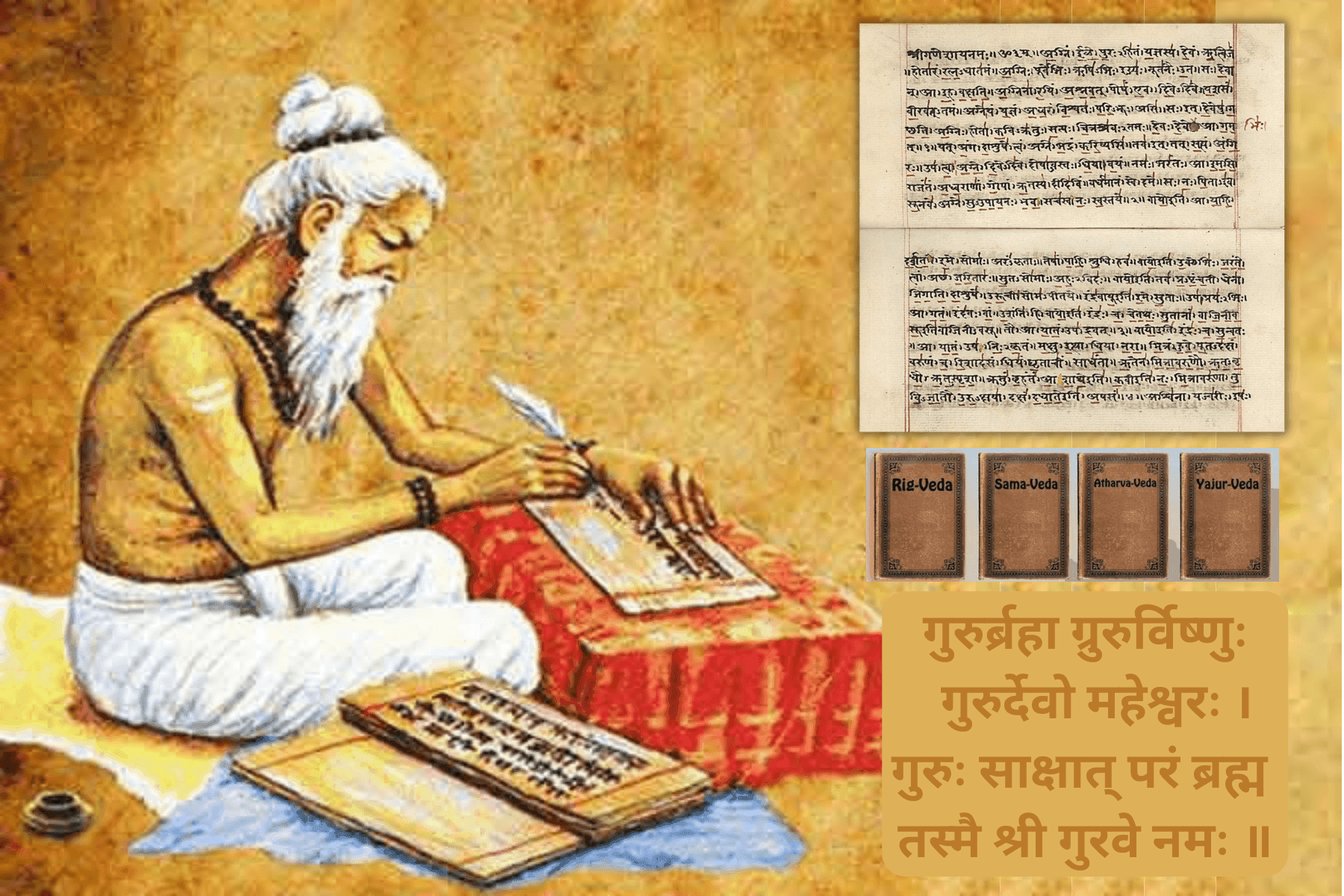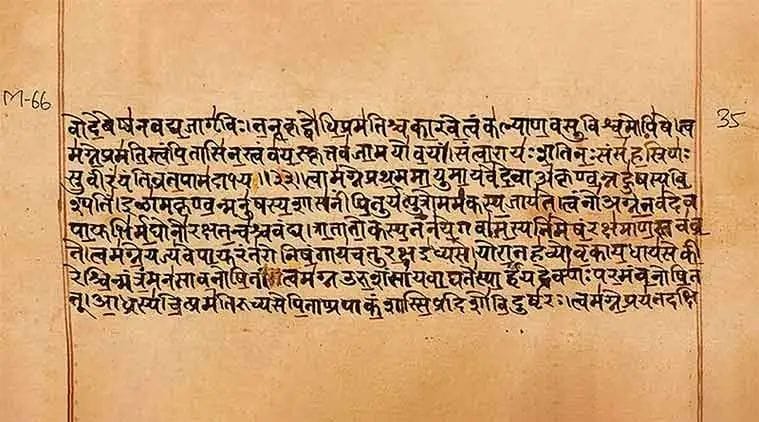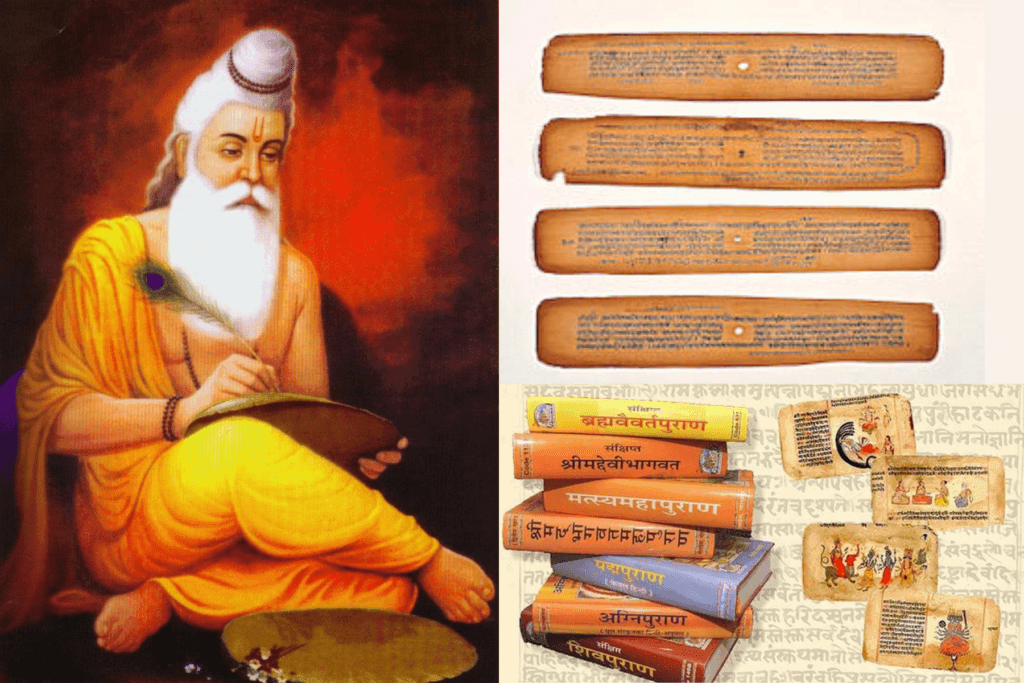
Dive into the Rig vedic literature Notes for UPSC with our comprehensive notes designed for competitive exam aspirants. Uncover the mysteries of this ancient civilization, exploring its history, cultural intricacies, and significance for your UPSC exam preparation.
Vedic Texts
- Shruti:
Shruti texts are considered sacred because they are believed to be the result of divine revelation to sages during meditation. These texts include the four Vedas and the Samhitas.
- Smriti:
Smriti texts are not considered as directly divine but are remembered and written down by regular people. They include six Vedangas, four Upvedas, and commentaries on the Vedas.
Vedas

The below mentioned are the 4 major vedas:
- Rig Veda:
The Rig Veda is the oldest Veda and tells us about the lives of ancient Vedic people in India. It has 1028 hymns, divided into 10 sections. Sections 2-7 are the oldest and are like family books for Rishis. Section 8 has hymns for different gods. Ayurveda is the associated upveda, and its Brahmana is called Aiteraya.
- Sam Veda:
The Sam Veda is a collection of verses from the Rig Veda. It includes the famous Dhrupad Raga, sung by Tansen. Its upveda is Gandharva Veda, and the associated Brahmana is Sadavimsha.
- Yajurveda:
Yajurveda explains how to perform sacrifices. It has two versions: Shukla Yajurveda, which has mantras, and Krishna Yajurveda, which has mantras along with explanations. The upveda of Yajurveda is Dhanur Veda, and its Brahmana is called Gopatha.
- Atharva Veda:
The Atharva Veda is different because it focuses on magic spells, protection, chants, prayers, and various rituals. It’s named after the priest Atharvan. This Veda is known for its healing and everyday practices. It’s the most recent of the Vedas and contains 5687 mantras in 20 chapters.
Vedangas:
Vedangas are like the “limbs” of the Vedas. They are created by humans and written as sutras, which are concise rules. There are six Vedangas:
- Shiksha (Phonetics) – How to pronounce words.
- Kalpa (Ritualistic science) – Guidelines for rituals.
- Jyotisha (Astronomy) – Study of celestial bodies.
- Vyakaran (Grammar) – Rules for language.
- Nirukta (Etymology) – Understanding the meanings of words.
- Chhanda (Metrics) – Measuring verses and poetry.
Upanishads:

- Upanishads are like the teachings learned by sitting close to a teacher.
- They are also known as Vedanta. There are 108 Upanishads, with 13 being the most important.
- They introduced ideas about Atma and Brahman, where Brahman is the unchanging essence of the universe.
- Upanishads are mainly philosophical and discuss profound knowledge.
- The saying “Satyamev Jayate” comes from the Mundaka Upanishad, and the Chandogya Upanishad talks about different stages of life and types of marriage.
Puranas:

Puranas means “ancient” or “old.” They are thought to be written by Ved Vyas. These texts cover various religious developments from the 5th and 6th centuries. Puranas are divided into 18 Mahapuranas and many Upapuranas. They are considered post-Vedic and talk about five subjects across different ages:
- Sarga – Creation of the universe.
- Pratisarga – Recreation after destruction.
- Manvantaras – Different Manus’ reigns.
- Vamsha – Genealogy of gods and sages.
- Vamshanucharita – History of Solar (Suryavanshis) and Lunar (Chandravanshis) dynasties.
- Dharmashastra- Dharmashastra is a text about morality and religious duties. It focuses on fulfilling the goals of life, which include Dharma (duty), Artha (prosperity), Kama (pleasure), and Moksha (liberation). Dharmashastra is divided into Dharma sutras and Smritis.
Important Points To Remember
Rigveda:
- The Rigveda is one of the oldest and most significant texts in ancient Indian literature.
- It consists of 10 Mandalas, 1,028 Suktas, and 10,580 Richas, making it a collection of hymns and praises to various deities.
- The Indus River, referred to as “Sindhu” in the Rigveda, is the most frequently mentioned river in this sacred text, holding great geographical and religious significance.
- UNESCO recognizes the Rig Veda as a piece of “World Human Heritage.
Seer Poets:
- Vishvamitra, Atri, Gritsamada, Vasishtha, and Bharadvaja are revered seer poets associated with the Rig Vedic age.
- They are known for composing hymns within the Rigveda, contributing to its rich content.
Vedas:
- The Rigveda is one of the four Vedas, along with the Sama Veda, Yajur Veda, and Atharva Veda.
- These Vedas are the primary sacred scriptures of Hinduism, with Aranyakas and Upanishads considered part of Vedic literature but not standalone Vedas.
Mandalas:
- The Rig Veda consists of 1,028 hymns divided into 10 Mandalas.
Family Books:
- Mandalas II to VII of the Rig Veda are often referred to as “family books” because they are attributed to specific families of seers or rishis, containing hymns composed by various poetical seers.
Upveda of Rig-Veda:
- Ayurveda, an ancient system of Indian medicine and healing, is considered the Upveda of the Rig Veda. It draws principles and knowledge from the Rigveda’s content.
Upveda of Samaveda:
- The Upveda of the Samaveda is called Gandharaveda, focusing on the science of music, melodies, and chants used in Vedic rituals and ceremonies.
Dhrupada Raga:
- The Dhrupada raga, emphasizing the importance of musicality in Vedic rituals, is found in the Sama Veda.
Recensions of Sama Veda:
- The Sama Veda has different recensions or Shakhas, including Kauthuma, Jaiminiya (Talavakara), and Ranayaniya, reflecting regional variations in the text.
Yajur Veda:
- The Yajur Veda deals with procedures and ritual-offering formulas for the performance of sacrifices, serving as a guide for priests conducting Vedic rituals.
Sanskrit Grammar:
- Panini is credited with writing Sanskrit Grammar, a foundational work in linguistics that laid the foundation for the grammatical structure of the Sanskrit language.
Yajur Veda Upveda:
- The Upveda of the Yajur Veda is called the Dhanuraveda, containing magic spells used during sacrifices.
Futuh-al-Salatin:
- “Futuh-al-Salatin” is authored by Khwaja Abu Malik Isami and provides an extensive historical account of the Delhi Sultanate’s history.
Srimad Bhagwad Gita Language:
- The Srimad Bhagwad Gita was originally written in Sanskrit and is part of the Indian epic Mahabharata.
Atharva Veda:
- The Atharva Veda is a distinct Veda focusing on magic spells and charms used to ward off evil spirits and diseases.
- It is divided into 20 kandas or books, containing 711 hymns.
Gopatha Brahmana:
- The Gopatha Brahmana is associated with the Yajur Veda and provides additional insights into the rituals and practices found in the Yajur Veda.
Satpatha Brahmana:
- The Satpatha Brahmana offers detailed guidelines for the performance of sacrificial ceremonies, including recommendations known as “one hundred sacred paths.”
Aranyakas:
- Aranyakas, known as the ‘forest books,’ are a category of Vedic texts focused on mysticism, philosophy, and spirituality, often opposing excessive rituals and sacrifices found in earlier Vedic literature.
Upanishads:
- There are over 200 Upanishads, with 13 being the most prominent.
- Upanishads explore profound topics related to the Atman (soul) and the concept of Brahman (ultimate reality).
“Satyamev Jayate” Upanishad:
- The phrase “Satyamev Jayate” is mentioned in the Mundaka Upanishad, a significant Upanishad.
Patanjali:
- Patanjali compiled the Yoga Sutras, a foundational text in the philosophy and practice of yoga.
Chhandogya Upanishad Marriage:
- The Chhandogya Upanishad discusses different types of marriages, including “Anuloma marriage.”
Vedanta:
- Vedanta reveals the final aim of the Vedas, emphasizing the pursuit of spiritual knowledge and realization while critiquing excessive ritualistic sacrifices.
Nyaya Darshan:
- Nyaya Darshan, a school of Indian philosophy dealing with logic and epistemology, was propagated by Gautama.
Vedanga:
- Vedangas are the ‘limbs of the Vedas,’ providing auxiliary texts for the proper understanding and application of the Vedas.
Sutras:
- There are different numbers of sutras in various ancient Indian texts.
Aryan Tribes Settlement:
- The earliest settlements of Aryan tribes were found in the Sapt-Sindhu region.
Purana Categories:
- Sarga, Pratisarga, Vansa, Manvantara, and Vanshanucharit are categories of Puranas.
MCQ Test on Rig-Vedic Literature



Leave a Reply